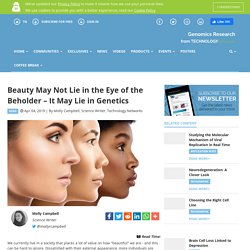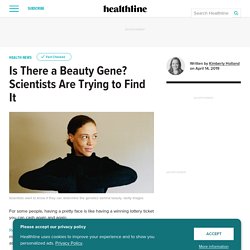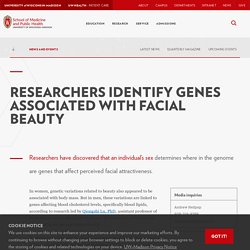

Welcome to CK-12 Foundation. Mitosis = cell division. The twisting tale of DNA - Judith Hauck. Deoxyribonucleic acid, or DNA, is a nucleic acid containing the genetic instructions used in the development and functioning of all known living organisms (with the exception of RNA viruses).

Which contains the biological instructions that make each species unique, along with the instructions it contains, is passed from adult organisms to their offspring during reproduction. National Human Genome Research Institute began as the National Center for Human Genome Research (NCHGR), which was established in 1989 to carry out the role of the National Institutes of Health (NIH) in the International Human Genome Project (HGP). The HGP was developed in collaboration with the United States Department of Energy and begun in 1990 to map the human genome. DNA The book of you Joe Hanson. Welcome to CK-12 Foundation. Drag-and-Drop Genetics: Monohybrid. Your genes are not your fate - Dean Ornish. Each cell in the human body contains about 25,000 to 35,000 genes, which carry information that go toward determining your traits.

Traits are characteristics you inherit from your parents; this means your parents pass some of their characteristics on to you through genes. For example, if both of your parents have green eyes, you might inherit the trait of green eyes from them. Learn.Genetics. Where do genes come from? - Carl Zimmer. Want to learn more about mutations and how essential they are to evolution?

The site has all the science you need to get a great background in this topic! Are mutations random? How do they affect an organism? Go here to find out more! How to make a Pedigree. Genomics Infographic. Humans Are All More Closely Related Than We Commonly Think. Genetics Basics: Six Things You Should Know - ASHG. A milestone in human genetics highlights diversity gaps. From the time that the nineteenth-century monk Gregor Mendel squinted at the pea plants in his garden and wondered why some had white flowers or wrinkled seeds, it has been a tradition in biology to observe what goes awry when a DNA sequence is altered — whether that variation occurs naturally or through human intervention.

Although geneticists have long been able to introduce genetic mutations into model organisms such as the fruit fly — first with X-rays or chemicals, and now with more sophisticated gene-editing tools — where humans are concerned, the toolbox is more limited. Researchers clearly cannot intentionally introduce mutations into humans; instead, they must use what nature provides. As a result, they comb through genomes in search of variations in DNA sequences, and use statistical tools to determine whether those variations contribute to traits and diseases. As genome sequencing has become quicker and cheaper, those studies have become bigger and more complex. Understanding Human Genetic Variation - NIH Curriculum Supplement Series - NCBI Bookshelf. The Basics on Genes and Genetic Disorders. Have people ever said to you, "It's in your genes"?

They were probably talking about a physical characteristic, personality trait, or talent that you share with other members of your family. We know that genes play an important role in shaping how we look and act and even whether we get sick. Now scientists are trying to use that knowledge in exciting new ways, such as treating health problems. What Is a Gene? To understand how genes work, let's review some biology basics. DNA contains four chemicals (adenine, thymine, cytosine, and guanine — called A, T, C, and G for short) that are strung in patterns on extremely thin, coiled strands in the cell. Nina Jablonski breaks the illusion of skin color. How racism makes us sick - David R. Williams. The Biology of Skin Color — HHMI BioInteractive Video. The science of skin color - Angela Koine Flynn. The beauty of human skin in every color. Is Height All In Our Genes? Beauty May Not Lie in the Eye of the Beholder – It May Lie in Genetics.
We currently live in a society that places a lot of value on how "beautiful" we are - and this can be hard to ignore.

Dissatisfied with their external appearance, more individuals are opting to go down the route of cosmetic surgery. Statistics from the American Society of Plastic Surgeons show that almost 18 million people underwent surgical and minimal invasive cosmetic procedure in the United States in 2018 – almost a quarter of a million more people than in 2017. In parallel, the cosmetics industry is one that continues to explosively grow, with the market value of skin care forecast to increase to $20.1 billion between 2014 and 2019.
Online, social media platforms have seen the rise of the "selfie", the Oxford Dictionaries Word of the Year 2013, and a common question thrown around is whether we are the most narcissistic generation to have ever lived. Genes related to attractiveness differ by sex Reference: Hu et al. (2019). Scientists Look for the Genes That Determine Beauty. For some people, having a pretty face is like having a winning lottery ticket you can cash again and again.

Researchers identify genes associated with facial beauty. Researchers have discovered that an individual’s sex determines where in the genome are genes that affect perceived facial attractiveness.

In women, genetic variations related to beauty also appeared to be associated with body mass. But in men, these variations are linked to genes affecting blood cholesterol levels, specifically blood lipids, according to research led by Qiongshi Lu, PhD, assistant professor of biostatistics and medical informatics at the University of Wisconsin School of Medicine and Public Health. “Interestingly, sex-specific genetic architecture of facial attractiveness was a recurrent pattern observed in almost all our analyses,” Lu said.
“Our results provided new insights into the genetic basis of facial attractiveness and have broad implications for the complex relationships between perceived attractiveness and various human traits.” The research was recently featured in the journal PLOS Genetics. Secrets of the X chromosome - Robin Ball. X chromosome inactivation is a necessary process that occurs in XX individuals early in development.

The X chromosome that will be inactivated expresses a long noncoding RNA molecule called Xist that recruits proteins to silence gene expression and to condense the chromosome. This process is described in more detail on the Scitable page about X-inactivation. Sex determination: More complicated than you thought - Aaron.
Most mammals, like humans have an XY genetic system for determining sex where XX produces females and XY produces males.

However, sometimes when sex chromosomes are dividing during meiosis, non-disjunction occurs and embryos are formed with numbers of sex chromosomes different from those that are typical. For example on occasion males have the sex chromosomes XXY or XYY. Understanding Genetics. — A curious adult from NJ March 18, 2020 What a thought-provoking question! First, it’s important to understand that biological sex and gender identity are not the same.
Male or female? It's not always so simple. “It’s not just black or white” is an adage heard so often that it borders on cliché. It underscores life’s complexities; wherever a gray area exists between two opposing endpoints, it asks us to consider the diverse realities and experiences that make life both more interesting yet harder to comprehend. When it comes to sex and gender, that “gray area” remains murky and mysterious — often undiscussed and even taboo. At UCLA, however, and elsewhere in the small but growing field of sex and gender biology, science is shedding light on this unfamiliar terrain. Dr. How this disease changes the shape of your cells - Amber M. Sickle cell disease is a complex medical condition that affects all of the organ systems in the body.
There are numerous types of sickle cell disease which vary in severity. It is thought that around 100,000 people in the United States suffer from sickle cell disease, however, the global burden of this disease is much more significant, particularly in sub-Saharan Africa and India. In the United States, babies are tested as newborns for sickle cell disease because early diagnosis and prompt treatment have been proven to improve the outcome for children diagnosed. Determining that these children were at risk for severe bacterial infections preventable simply with penicillin changed sickle cell disease from being viewed as simply a childhood disorder to a life-long medical condition.
Genetic Disorders. A genetic disorder is a disease caused in whole or in part by a change in the DNA sequence away from the normal sequence. Genetics of Learning Abilities and Disabilities: Recent Developments from the UK and Possible Directions for Research in China. What role do genetics play. How does chemotherapy work? - Hyunsoo Joshua No. Cancer, the uncontrollable growth of malignant cells, is an unfortunate occurrence of human life. Cancer. The Genetics of Cancer. Genetic Changes and Cancer Cancer is a genetic disease—that is, cancer is caused by certain changes to genes that control the way our cells function, especially how they grow and divide.
Genes carry the instructions to make proteins, which do much of the work in our cells. Certain gene changes can cause cells to evade normal growth controls and become cancer. For example, some cancer-causing gene changes increase production of a protein that makes cells grow. Others result in the production of a misshapen, and therefore nonfunctional, form of a protein that normally repairs cellular damage. American Cancer Society.